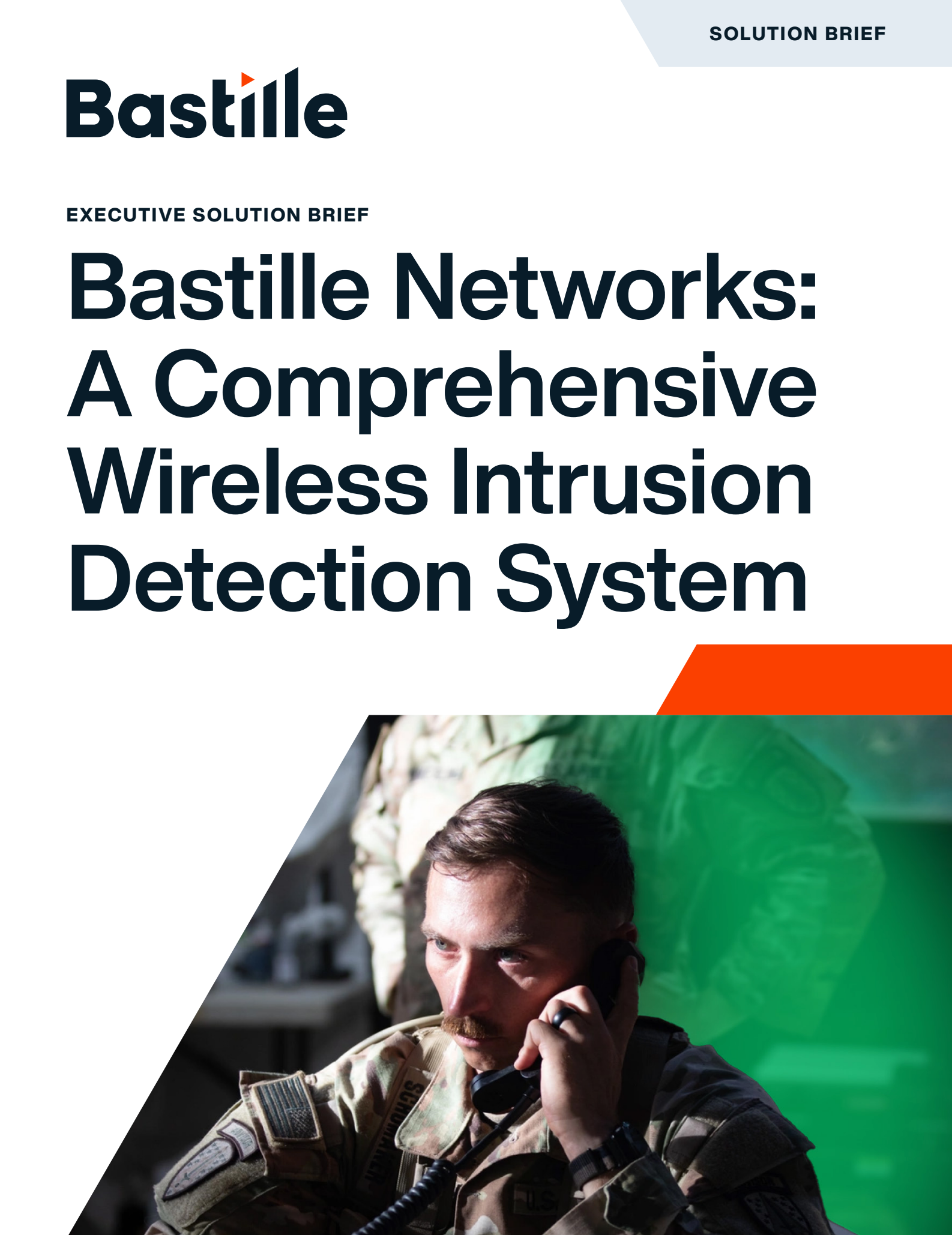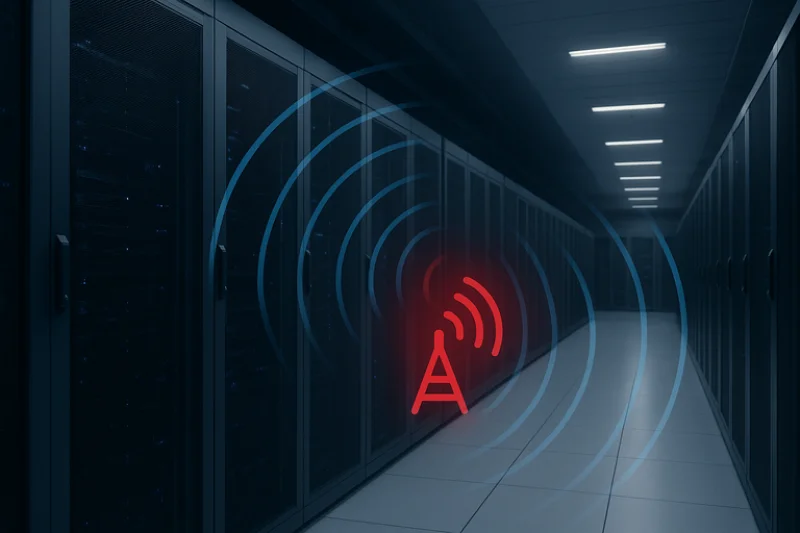
Part 1 of 3: The Hidden Wireless Perimeter of the Data Center
Data centers are among the most protected environments in modern infrastructure. Every door is locked, every connection monitored, and every process documented. Yet even within these high-security facilities, one domain often lies beyond traditional monitoring: the wireless perimeter.
This perimeter encompasses all signals that travel through or around the data center, including Wi-Fi, Bluetooth, cellular, IoT protocols like Zigbee, and other radio-frequency transmissions. While these technologies power automation, efficiency, and scalability, they also create an unseen layer of risk. Each signal represents a potential pathway that extends beyond the facility’s physical and digital boundaries.
In traditional enterprise data centers, this risk is significant. In AI-driven, hyperscale, and classified environments, it is exponential. The density of devices, reliance on automation, the sensitivity of stored and processed data, and the constant evolution of workloads have made wireless visibility an operational necessity.
This first article in the Securing the Wireless Perimeter series explores how the modern data center’s boundary has expanded, why wireless activity has become a critical security concern, and what leaders can do to protect their organizations from this emerging risk frontier.
From a Controlled Perimeter to a Connected Ecosystem
For decades, data centers operated on a simple premise: physical security plus wired infrastructure equals control. Facilities connected devices through physically traceable cables, tightly managed access, and logged all activity.
Today, that model has evolved into a highly connected ecosystem. Data centers of all sizes, whether AI, enterprise, colocation, cloud, or hyperscale, depend on wireless technologies to support daily operations.
Classified data centers face a distinct version of this challenge. These facilities operate under strict security and access constraints, yet still depend on wireless technologies for monitoring, maintenance, and control. Even limited-use devices, such as encrypted communication tools or wireless sensors for environmental stability, introduce potential exposure. Their operational restrictions make visibility even more critical, as traditional network inspection tools are often segmented or prohibited from operating in secure zones.
Technicians utilize tablets and smartphones for diagnostic purposes. Facility teams deploy Bluetooth and Wi-Fi sensors for environmental monitoring. Robots use wireless communication for inventory handling and cable management. Even power and cooling systems now incorporate IoT-enabled controllers that broadcast data to remote monitoring platforms.
This transformation has created a dual boundary within every facility:
- The physical perimeter, controlled through access systems and physical barriers
- The wireless perimeter, defined by every signal emitted by authorized and unauthorized devices alike
While physical security remains visible and enforced, the wireless layer spans hundreds of devices and multiple technologies, often remaining unmonitored.
The result is a security gap that grows wider with every new connection.
How Wireless Connectivity Expands the Threat Landscape
Wireless signals are essential to operational efficiency, but they also introduce risk. They can travel through walls and containment zones, reach beyond physical barriers, and originate from devices that security teams may not even be aware exist in the space.
- Rogue Access Points: Unauthorized Wi-Fi devices, whether intentionally placed or accidentally deployed, can create backdoors into sensitive networks. These may take the form of portable hotspots, personal access points, or legacy devices left active after a project ends.
- Embedded Cellular Connectivity: Modern servers, laptops, and IoT systems often include LTE or 5G modems for remote connectivity. These channels operate independently of managed networks, allowing unmonitored communication to the outside world.
- Short-Range Devices: Data center personnel frequently utilize Bluetooth and other short-range wireless technologies, such as diagnostic wands, keyboards, and wireless headsets, for convenience and efficiency. However, these devices can inadvertently expose credentials or broadcast sensitive data, especially if they are compromised or cloned.
- Misconfigured IoT and Automation Systems: Wireless-enabled cooling systems, access controls, and energy monitors are now standard. If misconfigured, they can broadcast operational data beyond the facility, leaking sensitive environmental information.
- Overlapping External Signals: AI training facilities, hyperscale campuses, multi-tenant, classified areas, and colocation centers may overlap geographically with other operators. Signals from nearby buildings, tenants, or support operations can overlap, creating interference that obscures malicious or unauthorized transmissions.
Each of these vectors operates outside the visibility of traditional tools. Firewalls cannot inspect wireless frequencies. Physical access systems cannot detect emissions. Wi-Fi-only tools monitor just a fraction of the spectrum. The rest remains hidden, forming an unmonitored perimeter that attackers, errors, or accidents can expose or exploit.
The Expanding Challenge in AI, Hyperscale, and Classified Data Centers
The evolution of hyperscale and AI infrastructure has intensified the challenge of wireless visibility.
Hyperscale Complexity: Global hyperscale operators manage facilities with millions of devices and components, many of which communicate wirelessly. Automation systems use radio-frequency (RF) telemetry to monitor cooling, airflow, and power distribution. Robotics platforms move hardware across massive halls using wireless control systems. Contractors and service teams rely on wireless diagnostics to maintain equipment.
Each transmission contributes to a constantly shifting RF environment. Even when every device is authorized, the sheer density of signals makes manual oversight impossible.
AI Data Center Density: AI-optimized facilities introduce an additional layer of complexity. These sites host clusters of GPUs and specialized accelerators that consume massive power and generate significant heat. Wireless systems control fans, coolant flow, and power efficiency. Thousands of sensors report environmental data every few seconds.
In these environments, the wireless perimeter extends far beyond the site’s physical boundaries. It becomes a living, breathing entity that changes continuously. Without automated monitoring, operators have no reliable way to identify unauthorized signals amid legitimate operational traffic.
Classified Data Center Security Constraints: In classified environments, the rules governing data and signal emissions are stringent. Even minor wireless transmissions can create compliance violations or trigger security incidents. These facilities often restrict or prohibit most forms of wireless communication, but complete elimination is rarely possible. Building systems, safety sensors, and maintenance tools may still emit or receive low-power signals. Without continuous visibility into all RF activity, classified facilities face the dual risk of regulatory non-compliance and insider-driven exposure.
Operational Consequences: The risks extend beyond cybersecurity. Wireless interference can degrade IoT performance, interrupt telemetry, or trigger false alerts. In AI data centers, where uptime and temperature control are critical, such disruptions can impact both reliability and efficiency.
Simply put: the wireless perimeter in AI, hyperscale, and classified environments is not just a theoretical concern but an operational one.
Why Traditional Security Tools Can’t See Wireless Threats
The problem is not that security teams lack vigilance; it’s that their tools cannot detect all wireless activity in the facility.
- Physical Controls: Cameras, sensors, and badge systems restrict access and detect movement, but they cannot determine whether someone’s phone is broadcasting a signal from within a secured zone.
- Network Controls: Firewalls, intrusion detection systems, and endpoint agents track traffic on known networks. However, they cannot identify devices that bypass those networks entirely through LTE, Bluetooth, or ad hoc Wi-Fi.
- Spectrum Analyzers: These tools measure signal strength but offer no contextual intelligence. They cannot distinguish between an authorized sensor and a rogue device transmitting at the same frequency.
- Wi-Fi Management Systems: Even advanced Wi-Fi controllers provide only partial coverage, limited to the 2.4 GHz and 5 GHz bands. In an environment where 5G, Bluetooth, and new 6–7 GHz Wi-Fi channels coexist, this coverage is no longer sufficient.
The result is a fragmented picture and an incomplete understanding of what is truly happening across the wireless perimeter.
Compliance and Wireless Visibility
Visibility into the wireless layer is not only good practice but also an increasing regulatory requirement.
Frameworks such as NIST 800-53, NIST 800-171, and ISO 27001 mandate that organizations monitor and control all communication channels to prevent unauthorized access. Wireless activity falls squarely within those expectations.
For AI and hyperscale operators supporting government or regulated industries, compliance extends beyond the basics. Frameworks such as FedRAMP and DoD SRG require documentation of security controls over both physical and electronic boundaries.
For classified data centers, verification is not just a differentiator but a requirement. Auditable evidence of continuous wireless monitoring supports adherence to national security standards and minimizes the risk of inadvertent emissions that could compromise secure operations.
Without visibility into wireless transmissions, it becomes impossible to demonstrate compliance with controls for device management, data protection, and incident response.
Beyond regulation, compliance has become a matter of trust. Enterprise and government clients expect providers to demonstrate holistic control of their environment, including wireless communications. In competitive hyperscale markets, verifying wireless visibility is now a differentiator, not an afterthought.
Passive Wireless Monitoring: Achieving Visibility Without Disruption
The challenge of wireless visibility is not just a matter of scale but a matter of practicality. Monitoring must be continuous, accurate, and non-intrusive.
Active scanning tools that transmit probes to identify nearby devices can cause interference or disrupt sensitive systems. Facilities may also restrict their use through operational policy.
A more effective approach is passive wireless monitoring, that is, listening across the entire spectrum rather than transmitting. Passive systems capture and analyze wireless activity, detecting every device that emits a signal, classifying its type and behavior, and alerting operators to anomalies in real time.
This approach provides complete visibility without compromising performance, making it ideal for hyperscale, classified, and AI environments where uptime and predictability are crucial.
When integrated with SIEM and SOAR platforms, passive wireless monitoring provides wireless context for incident response, compliance reporting, and risk assessment. For executives and directors, it offers measurable operational assurance and provides visibility that strengthens both governance and trust.
The Wireless Perimeter as a Strategic Priority
The concept of a “perimeter” has evolved. Once defined by walls and network boundaries, it now extends into every corner of the electromagnetic spectrum.
For data center leaders, the wireless perimeter represents both a challenge and an opportunity:
- A challenge, because it introduces risks that conventional controls cannot detect.
- An opportunity, because organizations that monitor this layer gain insight that others cannot, thereby reducing risk, improving compliance, and enabling smarter operations.
Monitoring the wireless perimeter enables leaders to shift from a reactive to a proactive defense. It transforms invisible risk into measurable improvements in security, strengthening the foundation of trust that underpins digital infrastructure.
Looking Ahead: Toward Unified Visibility
The wireless perimeter will only grow more complex. As Wi-Fi 6E, Wi-Fi 7, and private 5G networks proliferate, the typical operational radio frequency spectrum found in today’s networks will become increasingly congested. AI-driven facilities will continue to deploy thousands of wireless sensors to manage workloads and environmental conditions.
Without visibility, this complexity becomes chaos. With passive monitoring, it becomes manageable.
Bastille: Visibility for the Wireless Perimeter
Bastille delivers continuous visibility across the wireless perimeter of modern data centers, whether AI-optimized, enterprise, colocation, hyperscale, or classified. Through 100% passive monitoring across the operational enterprise wireless spectrum, Bastille detects, identifies, and alerts on every wireless device in range without interfering with operations.
As wireless connectivity becomes the foundation of data center automation and scalability, securing that layer is essential. Bastille provides visibility into what others can’t see: the full wireless perimeter that defines modern data center security.
Next in the Series: Closing the Wireless Visibility Gap
This first article in the Securing the Wireless Perimeter series introduces the scope and urgency of the issue. The next installment, “Closing the Wireless Visibility Gap,” will examine how operators can integrate wireless monitoring into their existing security and compliance frameworks to transform visibility into operational intelligence.




